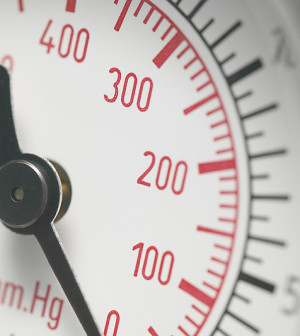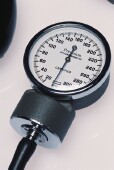- Skip Storing This Everyday Product in the Fridge Door
- Green Tea + B3 Pairing May Boost Brain Health
- Navigating Your Midlife Crisis: Embracing New Possibilities
- City Raccoons Showing Signs of Domestication
- Mapping the Exposome: Science Broadens Focus to Environmental Disease Triggers
- One Week Less on Social Media Linked to Better Mental Health
- Your Brain Changes in Stages as You Age, Study Finds
- Some Suicide Victims Show No Typical Warning Signs, Study Finds
- ByHeart Formula Faces Lawsuits After Babies Sickened With Botulism
- Switch to Vegan Diet Could Cut Your Greenhouse Gas Emissions in Half
Home Blood Pressure Monitoring Likely Saves Money, Study Finds


Insurance companies should cover home blood pressure-monitoring kits because the devices could bring savings in patient health care costs over the long term, new research indicates.
“Home blood pressure monitors should be reimbursed, widely adopted across America and integrated into current clinical practice for diagnosis and treatment of hypertension,” lead author Alejandro Arrieta, assistant professor in the department of health policy and management at Florida International University in Miami, said in an American Heart Association news release.
“By improving the accuracy of their blood pressure assessment and by monitoring their blood pressures outside the clinic setting, patients help themselves, help their physicians and save money for insurance companies,” Arrieta said.
“Our study provides evidence that reimbursement makes business sense for an insurance company,” he added.
More than 76 million American adults have diagnosed high blood pressure, also known as hypertension, and many more have undiagnosed high blood pressure. High blood pressure often has no symptoms, making periodic testing important. With a home monitoring kit people can test their blood pressure at regular intervals over several days or weeks.
People with high blood pressure should monitor their blood pressure levels at home, along with regular monitoring by their doctor, according to the American Heart Association, which recommends that patients be reimbursed if they buy a home monitoring kit.
For the study, researchers analyzed data collected between 2008 and 2011 from almost 34,000 people in two health insurance plans. The investigators found high blood pressure in 6 percent of people aged 20 to 44, 34 percent of those aged 45 to 64, and 60 percent of those 65 and older.
Depending on the insurance plan and client age, the study found net savings achieved with home blood pressure monitoring ranged from $33 to $166 per person in the first year, and $415 to $1,364 over 10 years.
For each dollar spent on home blood pressure kits, insurers could expect a return of 85 cents to $3.75 in the first year, and $7.50 to $19.34 over 10 years, according to the study released online July 14 in the journal Hypertension.
More information
The U.S. National Library of Medicine has more about high blood pressure.
Source: HealthDay
Copyright © 2025 HealthDay. All rights reserved.










